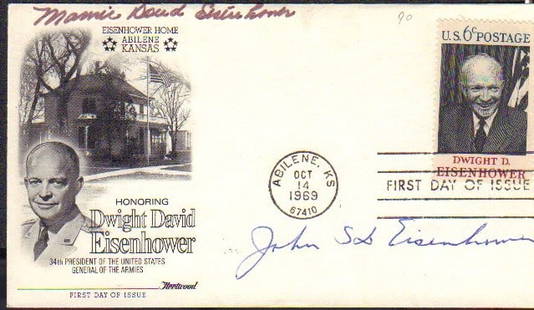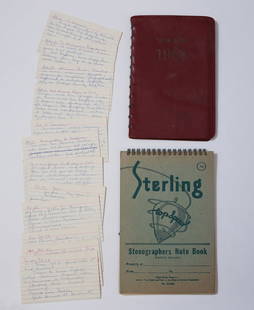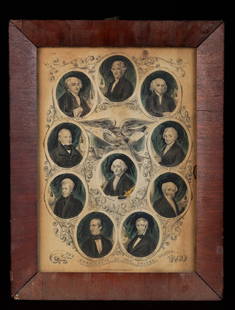
1789 John Dunlap Newspaper First President Electors
Similar Sale History
View More Items in Political MemorabiliaRelated Political Memorabilia
More Items in Political Memorabilia
View MoreRecommended Historical Memorabilia
View More










Item Details
Description
Federal Period
Historic Content 1789 John Dunlap Newspaper Lists Pennslyvania Electors for First President & Vice President
February 10, 1789-Dated Federal Period, "THE PENNSYLVANIA PACKET, AND DAILY ADVERTISER", reposting the State's Electors to Vote for President and Vice President of the United States, Custom Matted and Framed, John Dunlap and David Claypoole, Market Street, Philadelphia, Choice Very Fine.
Single Issue Important Content historic 1st President, George Washington related Newspaper. Four pages, complete, measures about 21.75" x 17.25" (by sight), matted and framed to 28.5" x 24.25" overall. Clean and well printed, some trivial clear virtually invisible archival tape reinforces a couple minor splits. Professionally matted and framed under special UV Plexiglas to fully display both sides and all text of this historic Philadelphia newspaper by John Dunlap (who printed the First Broadside of the Declaration of Independence). There is a report on page 3 at the bottom of the 3rd column that per Act of fourth day of October last (1788) all Pennsylvania's Assembly's Election of Congressmen and of the State's Electors to Vote for President and Vice President of the U.S. are named. A Farm, Land and property previously where William Penn actually lived, is offered for sale. Additionally, a Lottery for lands to be provided to Revolutionary War soldiers is held, together with typical commercial, shipping, and legal notices, including a descriptive notice regarding "A Runaway Negro" (Slave), stating: "Any person claiming him may have him, providing property and paying charges." Ready to hang on display.
John Dunlap (1747-1812) was an Irish printer who printed the first copies of the United States Declaration of Independence, and was one of the most successful Irish/American printers of his era. He served in the Continental Army under George Washington during the American Revolutionary War.
n 1776, Dunlap secured a lucrative printing contract for the Continental Congress. In July 1776, fighting between the American colonists and the British forces had been going on for over a year. On 2 July, the Second Continental Congress voted on the Lee Resolution to secede. Two days later, they approved the final wording of a public declaration regarding their decision, which we today call the Declaration of Independence. President of Congress John Hancock signed the fair copy with Secretary of Congress Charles Thomson attesting it. That evening Hancock ordered Dunlap to print broadside copies of the declaration. Dunlap printed perhaps 200 broadsides, since known as the "Dunlap broadsides", which were the first published versions of the Declaration.
Dunlap also printed items for Pennsylvania's revolutionary government. In 1777 he took over the printing of the Journals of the Continental Congress from Robert Aitken, but lost the contract in 1779 after printing in his newspaper a letter from Thomas Paine that leaked news of the secret French aid to the Americans.
_____
In 1789, the first presidential election, George Washington was unanimously elected president of the United States. With 69 electoral votes, Washington won the support of each participating elector. No other president since has come into office with a universal mandate to lead.
Between December 15, 1788 and January 10, 1789, the presidential electors were chosen in each of the states. On February 4, 1789, the Electoral College convened. Ten states cast electoral votes: Connecticut, Delaware, Georgia, Maryland, Massachusetts, New Hampshire, New Jersey, Pennsylvania, South Carolina, and Virginia. New York, however, failed to field a slate of electors. North Carolina and Rhode Island were unable to participate because they had not yet ratified the Constitution. After a quorum was finally established, the Congress counted and certified the electoral vote count on April 6.
Washington was both an obvious first choice for president and possibly the only truly viable choice. He was both a national hero and the favorite son of Virginia, the largest state at the time. Washington ascended to the presidency with practical experience, having served as the commander-in-chief of the Continental Army during the American Revolution and president of the 1787 Constitutional Convention in Philadelphia.
According to Article II of the U.S. Constitution, each elector in the Electoral College possessed two votes. The candidate who received a majority of the votes was elected president. The candidate with the second most votes in the Electoral College, whether a majority or a plurality, was elected vice president. Behind Washington, John Adams, who most recently had served as the first U.S. ambassador to Great Britain, finished with 34 electoral votes and became the first vice president of the United States. Being from Massachusetts, Adams' election provided the administration a regional balance between the South and North. Other candidates receiving multiple electoral votes were John Jay (9), Robert Harrison (6), John Rutledge (6), John Hancock (4), and George Clinton (3). Five candidates split the remaining seven votes.
Upon hearing the news of his decisive election, George Washington set out from Mount Vernon to take his place in presidential history. Though filled with great anxiety, Washington reported for duty "in obedience to the public summons" and explained that "the voice of my Country called me."
On April 30, 1789, at Federal Hall in New York City, the first capital of the United States, Washington took the presidential oath of office. With a hand on the Bible, a "sacred volume" borrowed from a local Masonic lodge and subsequently known as the "George Washington Inaugural Bible," he said, "I, George Washington, do solemnly swear that I will faithfully execute the Office of President of the United States, and will to the best of my Ability, preserve, protect and defend the Constitution of the United States."
At that moment, the Chancellor of the State of New York, Robert Livingston, the person who administered the oath to the first chief executive, exclaimed, "Long live George Washington, President of the United States!"
Historic Content 1789 John Dunlap Newspaper Lists Pennslyvania Electors for First President & Vice President
February 10, 1789-Dated Federal Period, "THE PENNSYLVANIA PACKET, AND DAILY ADVERTISER", reposting the State's Electors to Vote for President and Vice President of the United States, Custom Matted and Framed, John Dunlap and David Claypoole, Market Street, Philadelphia, Choice Very Fine.
Single Issue Important Content historic 1st President, George Washington related Newspaper. Four pages, complete, measures about 21.75" x 17.25" (by sight), matted and framed to 28.5" x 24.25" overall. Clean and well printed, some trivial clear virtually invisible archival tape reinforces a couple minor splits. Professionally matted and framed under special UV Plexiglas to fully display both sides and all text of this historic Philadelphia newspaper by John Dunlap (who printed the First Broadside of the Declaration of Independence). There is a report on page 3 at the bottom of the 3rd column that per Act of fourth day of October last (1788) all Pennsylvania's Assembly's Election of Congressmen and of the State's Electors to Vote for President and Vice President of the U.S. are named. A Farm, Land and property previously where William Penn actually lived, is offered for sale. Additionally, a Lottery for lands to be provided to Revolutionary War soldiers is held, together with typical commercial, shipping, and legal notices, including a descriptive notice regarding "A Runaway Negro" (Slave), stating: "Any person claiming him may have him, providing property and paying charges." Ready to hang on display.
John Dunlap (1747-1812) was an Irish printer who printed the first copies of the United States Declaration of Independence, and was one of the most successful Irish/American printers of his era. He served in the Continental Army under George Washington during the American Revolutionary War.
n 1776, Dunlap secured a lucrative printing contract for the Continental Congress. In July 1776, fighting between the American colonists and the British forces had been going on for over a year. On 2 July, the Second Continental Congress voted on the Lee Resolution to secede. Two days later, they approved the final wording of a public declaration regarding their decision, which we today call the Declaration of Independence. President of Congress John Hancock signed the fair copy with Secretary of Congress Charles Thomson attesting it. That evening Hancock ordered Dunlap to print broadside copies of the declaration. Dunlap printed perhaps 200 broadsides, since known as the "Dunlap broadsides", which were the first published versions of the Declaration.
Dunlap also printed items for Pennsylvania's revolutionary government. In 1777 he took over the printing of the Journals of the Continental Congress from Robert Aitken, but lost the contract in 1779 after printing in his newspaper a letter from Thomas Paine that leaked news of the secret French aid to the Americans.
_____
In 1789, the first presidential election, George Washington was unanimously elected president of the United States. With 69 electoral votes, Washington won the support of each participating elector. No other president since has come into office with a universal mandate to lead.
Between December 15, 1788 and January 10, 1789, the presidential electors were chosen in each of the states. On February 4, 1789, the Electoral College convened. Ten states cast electoral votes: Connecticut, Delaware, Georgia, Maryland, Massachusetts, New Hampshire, New Jersey, Pennsylvania, South Carolina, and Virginia. New York, however, failed to field a slate of electors. North Carolina and Rhode Island were unable to participate because they had not yet ratified the Constitution. After a quorum was finally established, the Congress counted and certified the electoral vote count on April 6.
Washington was both an obvious first choice for president and possibly the only truly viable choice. He was both a national hero and the favorite son of Virginia, the largest state at the time. Washington ascended to the presidency with practical experience, having served as the commander-in-chief of the Continental Army during the American Revolution and president of the 1787 Constitutional Convention in Philadelphia.
According to Article II of the U.S. Constitution, each elector in the Electoral College possessed two votes. The candidate who received a majority of the votes was elected president. The candidate with the second most votes in the Electoral College, whether a majority or a plurality, was elected vice president. Behind Washington, John Adams, who most recently had served as the first U.S. ambassador to Great Britain, finished with 34 electoral votes and became the first vice president of the United States. Being from Massachusetts, Adams' election provided the administration a regional balance between the South and North. Other candidates receiving multiple electoral votes were John Jay (9), Robert Harrison (6), John Rutledge (6), John Hancock (4), and George Clinton (3). Five candidates split the remaining seven votes.
Upon hearing the news of his decisive election, George Washington set out from Mount Vernon to take his place in presidential history. Though filled with great anxiety, Washington reported for duty "in obedience to the public summons" and explained that "the voice of my Country called me."
On April 30, 1789, at Federal Hall in New York City, the first capital of the United States, Washington took the presidential oath of office. With a hand on the Bible, a "sacred volume" borrowed from a local Masonic lodge and subsequently known as the "George Washington Inaugural Bible," he said, "I, George Washington, do solemnly swear that I will faithfully execute the Office of President of the United States, and will to the best of my Ability, preserve, protect and defend the Constitution of the United States."
At that moment, the Chancellor of the State of New York, Robert Livingston, the person who administered the oath to the first chief executive, exclaimed, "Long live George Washington, President of the United States!"
Buyer's Premium
- 30%
1789 John Dunlap Newspaper First President Electors
Estimate $800 - $1,200
2 bidders are watching this item.
Shipping & Pickup Options
Item located in Rancho Santa Fe, CA, usOffers In-House Shipping
Payment

Related Searches
TOP





















![[Presidents] Four Newspapers Pertaining to Thomas Jefferson, John Quincy Adams, Zachary Taylor, and: [Presidents] Four Newspapers Pertaining to Thomas Jefferson, John Quincy Adams, Zachary Taylor, and Franklin D. Roosevelt. Newspapers include: National Intelligencer, Washington, Oct. 23, 1807, with a](https://p1.liveauctioneers.com/1108/249127/129334876_1_x.jpg?height=310&quality=70&version=1653090066)











![[PRESIDENTS] Collection of signed books and an interesting newspaper showing Nixon in China.: [PRESIDENTS] Collection of signed books and an interesting newspaper showing Nixon in China. Comprising: BUSH, GEORGE, W. Decision Points. New York: Crown, [2010]. First edition, a signed copy from th](https://p1.liveauctioneers.com/292/267300/139722770_1_x.jpg?height=310&quality=70&version=1667424219)












![John Tyler PSA NM-MT 8 FF Sent to Mother-in-Law in Staten Island: John Tyler[Richmond, VA], November 6, 1856John Tyler PSA NM-MT 8 FF Sent to Mother-in-Law in Staten IslandFree FrankA free franked transmittal cover signed by former 10th U.S. President John Tyler (17](https://p1.liveauctioneers.com/6306/327579/176471695_1_x.jpg?height=310&quality=70&version=1714074043)
![10 Days After His Assassination JFK Signed W. H. letter, Fantastic! Among JFK's Last Acts in White H: John F. Kennedy[Washington, D.C.], December 2, 196310 Days After His Assassination JFK Signed W. H. letter, Fantastic! Among JFK's Last Acts in White House Post Dated Before Dallas TripTLSJOHN F. KENN](https://p1.liveauctioneers.com/6306/327579/176471594_1_x.jpg?height=310&quality=70&version=1714074043)








![Reagan Presidential "Camp David" Pickard China Dinner Plate: Presidential[Camp David], n.d.Reagan Presidential "Camp David" Pickard China Dinner PlateTablewareA Pickard China (Antioch, Illinois) dinner plate, almost certainly dating from the Reagan ad](https://p1.liveauctioneers.com/6306/327579/176471666_1_x.jpg?height=310&quality=70&version=1714074043)







![Lincoln Brady Photo Study for Carpenter's "First Reading of the Emancipation Proclamation," Meserve : Abraham Lincoln[New York, NY], Early 20th centuryLincoln Brady Photo Study for Carpenter's "First Reading of the Emancipation Proclamation," Meserve Printed & CollectedPhotographA photograph](https://p1.liveauctioneers.com/6306/327579/176471611_1_x.jpg?height=310&quality=70&version=1714074043)












![S. Sewall Court Document Involving Three Participants in Salem Witch Trials: Salem Witch TrialsSalem, MA, 17th centuryS. Sewall Court Document Involving Three Participants in Salem Witch TrialsADS[WITCHCRAFT.] Stephen Sewall, Autograph Document Signed, Writ of Attachment in Ma](https://p1.liveauctioneers.com/6306/327579/176471806_1_x.jpg?height=310&quality=70&version=1714074043)